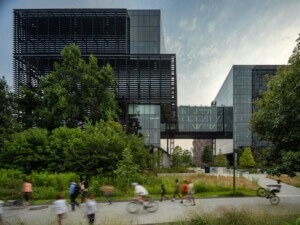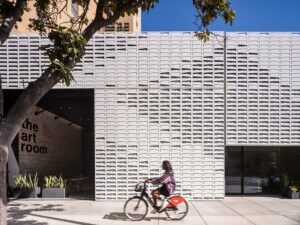Audi and GSAPP teamed with FLATCUT_ to create a 1:1500 scale model of Manhattan’s street grid from 3/16-inch-thick aluminum sheets
This September at the preview of the Lowline Park in Manhattan’s Lower East Side, visitors had the opportunity to absorb nine visions by students from Columbia University Graduate School of Architecture Planning and Preservation (GSAPP) about the future of urban living and mobility. Conducted as the culmination of a yearlong research program in partnership with Audi of America, the exhibition, Experiments in Motion, was tied together and contextualized by a hanging, 50-foot-long, 1:1500 scale model of Manhattan’s street grid. Audi and GSAPP called on New York and New Jersey-based fabrication studio FLATCUT_ to create the model, which also calls out every subway station on the island. The job required the studio to pull off a high wire balancing act: the fabrication of an object both intricate and sturdy, modular yet monolithic.
- Fabricator FLATCUT_
- Designer Therrien-Barley
- Location New York City
- Date of Completion September 2012
- Materials 3/16-inch aluminum sheets
- Process Rhino, CNC water jet cutting, welding
The Manhattan street grid had to float amid a sea of colorful projections emanating from the student’s exhibits, which were presented in digital format. Light from the screens had to be able to dance across the model. Equally important to the exhibit, the model had to work with a projection by Nuite Blanch New York that created the appearance of a heavy shadow. Silhouetting the street grid upon the digital displays, the model placed the projections in context. “That was pretty unique,” said FLATCUT_’s Tomer Ben-Gal. “The model had to be both reflective and have the ability to cast a shadow.” In close collaboration with the Therrien-Barley design team, FLATCUT_ studied several materials to find the right one to render the complex line work of Manhattan’s street grid. “It was critical that we identify an alloy that was both strong enough to hold the piece up, but not too thick that it would become difficult to cut the fine pattern they were looking to achieve,” added FLATCUT_’s Daniel Ramirez. FLATCUT_ went with 3/16-inch aluminum sheets. The studio revised the detail of the design team’s line drawings in Rhino, refining the grid so it could be cut using a water jet cutter. They also broke the overall model down into modular parts that could fit through the CNC cutting machine. After consulting with the designers on a variety of reflective finishes, the team decided to leave the raw look of the aluminum’s mill finish.
Once cut, the modular pieces of the model were welded together in FLATCUT_’s New Jersey fabrication shop with flanges, creating a smooth, unbroken appearance to the finished product. Once assembled, Art Domantay hoisted the unit in place with aircraft cables connected to the flanges. FLATCUT_’s attention to detail throughout the process is evident in just how seamlessly their ghostly Manhattan melded with the digital projections that comprise the rest of the exhibit. “It was interesting,” Ramirez said, “to apply our skills as fabricators of physical pieces to digital interactions.”










